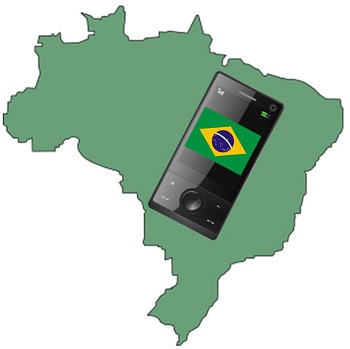According to a recent announcement among top industry players, Brazil isn’t reaching its full m-commerce potential.
Some of the top players in the mobile commerce industry in Brazil have now revealed that this channel is being held back by limited profit margins and unstable broadband service in the country for medium and small sized retailers.
Moreover, there is also an overall lacking in terms of the awareness of the potential of m-commerce in this sector.
This, according to the primary mobile commerce complaints that were brought up during the Mobile+ forum which held panel discussions in São Paulo. Among the top problems that were identified during these discussions were the low profit margins that could be expected by retailers who participated in promotions such as “deal of the day” strategies. According to the CEO of the Kekanto city guide service, Fernando Okumura, “Sometimes the price of the ticket you can charge from a small retailer is not enough to be profitable.”
This shows that it is very difficult for smaller businesses to keep up with the requirements of mobile commerce.
 The issue isn’t necessarily with the methods that are available. Instead, it is in the understanding of the m-commerce channel, as a whole. For example, it was pointed out that it seems that small retailers may not be realizing that these daily deal coupons are designed to be used as an opportunity to advertise to a vast audience, as opposed to actually being an opportunity to profit from that specific sale.
The issue isn’t necessarily with the methods that are available. Instead, it is in the understanding of the m-commerce channel, as a whole. For example, it was pointed out that it seems that small retailers may not be realizing that these daily deal coupons are designed to be used as an opportunity to advertise to a vast audience, as opposed to actually being an opportunity to profit from that specific sale.
For example, many businesses use daily deal smartphone marketing coupons to get consumers in through the doors of their businesses. While they may not profit on the specific sale associated with the coupon, those same consumers may purchase something else while they are there, or they may learn about the businesses and return again another time, becoming a regular shopper.
Therefore, while this mobile commerce technique should be considered to be an advertising expense, it is being misinterpreted by some businesses and their opportunity is, therefore, being lost. This illustrates a clear need for greater education of businesses with regards to the use of mobile marketing and shopping offers and the way that smartphones can generate greater sales in-store.
Geolocation technology is opening new opportunities for mobile advertising in previously unused places.
A new form of location based marketing is now being made possible through a strategic partnership between Captive Networks and xAd, allowing targeted ads to be displayed in the form of video in previously unused (or limited use) places, such as elevators and lobbies.
In-office advertising using geolocation technology will soon be enhancing displays for improved reach.
The two companies in this partnership are hoping to reinforce their brand messaging through the use of integrated location based marketing techniques and mobile ad delivery. They say that this strategy can be verified based on the actual position of the ad viewers based on the longitude and latitude of approximately 12,000 different Captivate screens that have already been installed into around 1,800 different office buildings throughout Canada and the United States.
Integrated location based marketing messages are also delivered by way of mobile devices such as smartphones.
 These messages give their viewers a way to actually respond or interact with them, say the partners in this program. By bringing mobile marketing into this strategy, it means that advertisers become capable of benefiting from performance metrics. To achieve this, SmartFencing, a geolocation based technology, is used by xAd, so that specific messages can be targeted in a campaign with several different multi-channel components.
These messages give their viewers a way to actually respond or interact with them, say the partners in this program. By bringing mobile marketing into this strategy, it means that advertisers become capable of benefiting from performance metrics. To achieve this, SmartFencing, a geolocation based technology, is used by xAd, so that specific messages can be targeted in a campaign with several different multi-channel components.
According to the xAd vice president of platform sales, Dan Hight, “We are pleased to partner with Captivate, a leader in the digital place-based advertising space.” He added that the location targeting solutions from xAd make it possible for advertisers to enhance their reach when it comes to sending ads outside of a consumer’s home through the use of campaigns aimed at specific places. This way, Captivate then gives marketers the ability to access their target audience more effectively by sending their messages over multiple channels.
This location based marketing method was soft launched in August and Captivate has now stated that its extended features have already been activated for certain select clients. Geolocation and geo-fencing are beginning to play an increasing role in mobile advertising as a whole.
 The issue isn’t necessarily with the methods that are available. Instead, it is in the understanding of the m-commerce channel, as a whole. For example, it was pointed out that it seems that small retailers may not be realizing that these daily deal coupons are designed to be used as an opportunity to advertise to a vast audience, as opposed to actually being an opportunity to profit from that specific sale.
The issue isn’t necessarily with the methods that are available. Instead, it is in the understanding of the m-commerce channel, as a whole. For example, it was pointed out that it seems that small retailers may not be realizing that these daily deal coupons are designed to be used as an opportunity to advertise to a vast audience, as opposed to actually being an opportunity to profit from that specific sale.
 These messages give their viewers a way to actually respond or interact with them, say the partners in this program. By bringing mobile marketing into this strategy, it means that advertisers become capable of benefiting from performance metrics. To achieve this, SmartFencing, a geolocation based technology, is used by xAd, so that specific messages can be targeted in a campaign with several different multi-channel components.
These messages give their viewers a way to actually respond or interact with them, say the partners in this program. By bringing mobile marketing into this strategy, it means that advertisers become capable of benefiting from performance metrics. To achieve this, SmartFencing, a geolocation based technology, is used by xAd, so that specific messages can be targeted in a campaign with several different multi-channel components.